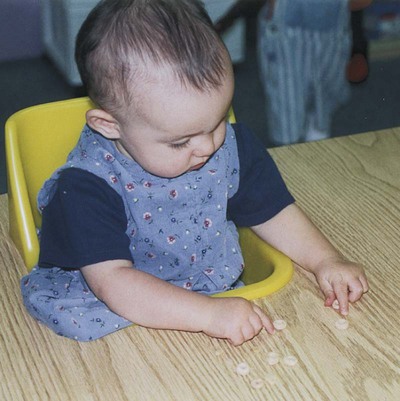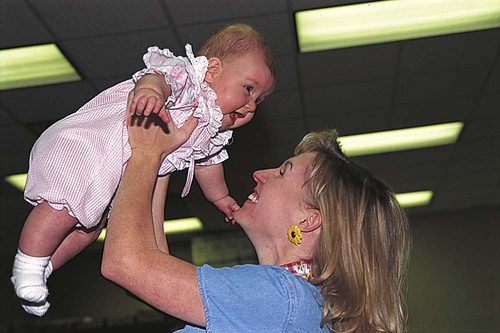1. Define the vocabulary terms listed 2. Discuss general characteristics of the infant including reflexes 3. Discuss the nutritional needs of growing infants 4. Describe the physical development of infants from 1 to 12 months 5. Describe the psychosocial development of infants from 1 to 12 months 6. Describe the care and guidance of infants from 1 to 12 months 7. Describe four developmental characteristics of infants that predispose them to certain hazards, for example, “Puts everything into mouth—danger of aspiration” 8. Discuss teething in infancy 9. Describe colic and recommendations for soothing a colicky baby The grasp reflex Love and security are vital for infants. Babies need continuous affection from their parents. Infants’ needs should be met in a loving, consistent manner that enables them to trust the people with whom they interact (Figure 6-2). Parents should be assured that they will not spoil infants if they respond to their needs. Loving adults help infants to build trust and to believe that the world is a good place. This development of a sense of trust is key to the development of a healthy personality. A sense of trust is thought to serve as a foundation on which all subsequent tasks are based. The lack of a sense of trust can have a negative effect on the rest of a child’s life because the child mistrusts people and regards the world with suspicion. Table 6-1 is a guide to infant care from the first month to the first year. Some aspects of care, such as safety measures, are important throughout the entire year. The nurse should explain to parents that physical patterns cannot be separated from social patterns and that abrupt changes do not take place with each new month. Like body structures that cannot be separated from their functions, human development cannot be cleanly divided into specific areas. In addition, because no two infants are exactly alike at any given age, the reference provided is just a guide. However, individual variations do range around central norms, which serve as indicators for the evaluation of an infant or child’s progress. For instance, although the time of occurrence may vary, an infant’s ability to sit without support is still a marker of developmental progress. Table 6-1 Social Behavior, Physical Development, Care, and Guidance for the First 12 Months
The Infant
General Characteristics and Development
![]() http://evolve.elsevier.com/Price/pediatric/
http://evolve.elsevier.com/Price/pediatric/
![]() (discussed in Chapter 5) occurs when one touches the palms of the infant’s hands and flexion takes place. This reflex disappears at about 3 months. Prehension, the ability to grasp objects between the fingers and the opposing thumb, occurs slightly later (at 5 to 6 months) and follows an orderly sequence of development. By 7 to 9 months, the parachute reflex appears. This is a protective arm extension that occurs when an infant is suddenly thrust downward when prone. By 1 year, the pincer grasp, reflecting coordination of index finger and thumb, is well established (Figure 6-1).
(discussed in Chapter 5) occurs when one touches the palms of the infant’s hands and flexion takes place. This reflex disappears at about 3 months. Prehension, the ability to grasp objects between the fingers and the opposing thumb, occurs slightly later (at 5 to 6 months) and follows an orderly sequence of development. By 7 to 9 months, the parachute reflex appears. This is a protective arm extension that occurs when an infant is suddenly thrust downward when prone. By 1 year, the pincer grasp, reflecting coordination of index finger and thumb, is well established (Figure 6-1).
Physical Development, Social Behavior, Care, and Guidance
AGE/SOCIALIZATION
PHYSICAL DEVELOPMENT
CARE AND GUIDANCE
1 Month
Gains 5 to 7 ounces weekly for the first 6 months; has regained the weight lost after birth; gains about 1 inch in length per month for the first 6 months; head circumference increases by 1.5 cm (  inch) monthly for the first 6 months.
inch) monthly for the first 6 months.
Lifts head slightly when placed on stomach; pushes with toes; turns head to the side when prone; head wobbles. Head lag when pulled from lying to sitting position (provide support to head when holding infant).
Obligatory nose breather.
Clenches fists; grasp reflexes are strong. Stares at surroundings.
Sleep: Place “back” to sleep; use firm, tight-fitting mattress in crib with bars spaced so baby’s head cannot be caught in between; raise crib rails; use no pillow or blanket; sleeps 20 hours. May use monitor system.
Nutrition: Breast milk every 2 to 3 hours or iron-fortified formula every 4 hours or as directed by health care provider; burp often; 400 international units/day of Vitamin D.
Hiccups: Are normal and require no treatment.
Immunization: May receive second dose of Hepatitis B vaccine.
Exercise: Provide fresh air, but do not allow to overheat; no sunscreen if younger than 6 months of age; avoid exposure to large crowds; provide colorful hanging toys for sensory stimulation.
Makes small throaty noises; cries when hungry or uncomfortable.
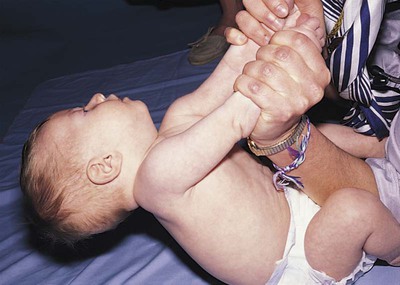
2 Months
Posterior fontanel closes. Tears appear. Can hold head erect in midposition; follows moving light with eyes.
Grasp reflex is fading; can hold a rattle briefly.Legs are active.
Needs assistance to maintain upright position.
Sleep: Develops own pattern; may sleep from feeding to feeding; guidelines follow 1 month old.
Nutrition: Increasing amount of breast milk or formula with Vitamin D supplement.
Immunization: See the Evolve Appendix.
Exercise: Provide safe, flat place for baby to kick and be active; never leave alone on raised surface. Provide tummy time.
Smiles in response to mother’s voice.
Knows crying brings attention.
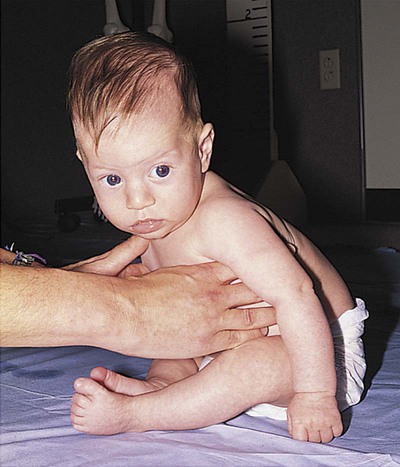
3 Months
Primitive reflexes fading; stares at hands; reaches for objects but misses them; carries hand to mouth; holds rattle.
Can follow an object from right to left and up and down; supports head steady.
Nutrition: Same as 1 to 2 months; amount of feeding has increased.
Exercise: May have short play periods; enjoys playing with hands and tummy time.
Can wait a few minutes for attention; enjoys responding to people.
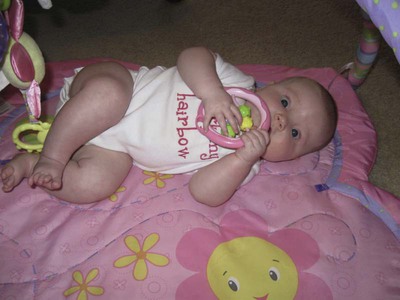
4 Months
Weighs about 13 to 14 pounds. Lifts head and shoulders when on abdomen and looks around. Turns from back to side; sits with support. Begins to reach for objects; coordination between eye and body movements.
Moves head, arms, and shoulders when excited; extends legs and partly sustains the weight when held upright. May play with feet and put toes in mouth.
Rooting, Moro, extrusion, and tonic neck reflexes are no longer present. Little head lag.
Drooling apparent; can breathe when nose is obstructed.
Sleep: 8 to 10 hours at night; stirs about in crib. Sleeps through ordinary household noises.
Nutrition: Continue breast milk or formula; may begin rice cereal.
Immunization: See the Evolve Appendix.
Exercise: Plays with hand rattles and dangling toys; may use playpen or safe area on floor when rolling safely is possible.
Coos, chuckles, gurgles, laughs aloud; makes consonant sounds “n,” “k,” “g,” “p,” and “b.” Responds to others; likes an audience.
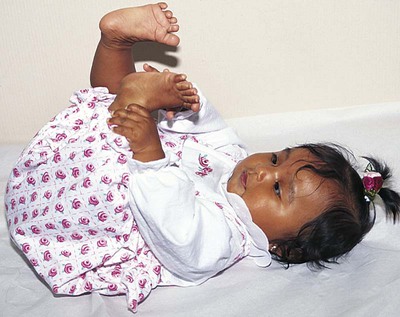
5 Months
Sits with support; holds head well.
Grasps preferred objects; puts everything into the mouth. Be sure toys have no small, removable parts.
Plays with toes. Shows signs of tooth eruption.
Sleep: Takes two to three naps a day.
Nutrition: Breast milk or formula; may have started cereal.
Exercise: Provide space for movement and rolling; makes jumping motions when held upright in lap.
Safety: The infant rides facing the rear of the vehicle, in the middle of the back seat. The infant seat is secured with the seat belt or latch system, and straps on the car seat adjust to accommodate the growing baby. When children reach the highest weight or length allowed by the manufacturer of their infant-only seat, they should continue to ride rear-facing in a convertible seat until age 2 (American Academy of Pediatrics, 2010).
“Talks” to self.
Seems to know whether persons are familiar or unfamiliar.
Discovers parts of the body; enjoys water play (never leave alone in water); tries to hold own bottle.
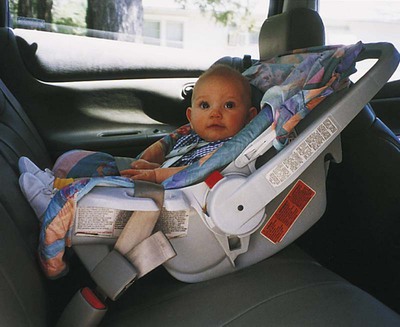
6 Months
Doubles in birth weight; gains 3 to 5 ounces per week during next 6 months.
Grows about  inch per month for the next 6 months.
inch per month for the next 6 months.
Head circumferences increases  cm (
cm ( inch) per month for the second 6 months.
inch) per month for the second 6 months.
Turns completely over. Pulls self to sitting position using hands for support and stability. No head lag is present; easily lifts head, chest, and upper abdomen and can bear weight on the hands.
Nutrition: Begin rice cereal fortified with iron if has not yet been started. Sucks food from spoon. Chewing more mature; approximates lips to rim of cup; bangs table with spoon.
Immunization: See the Evolve Appendix
Safety: Remove toxic plants from baby’s reach. Babyproof house if not done yet (electrical plugs and cabinet locks are essential).
Shows increased interest in surrounding world.
Babbles and squeals; wakes up happy.
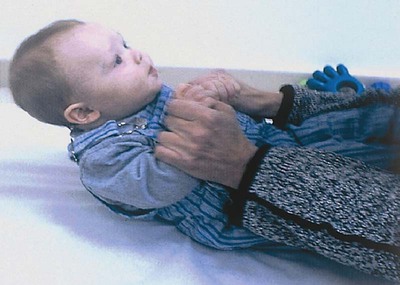
![]()
Stay updated, free articles. Join our Telegram channel

Full access? Get Clinical Tree

 Get Clinical Tree app for offline access
Get Clinical Tree app for offline access

The Infant
Get Clinical Tree app for offline access
